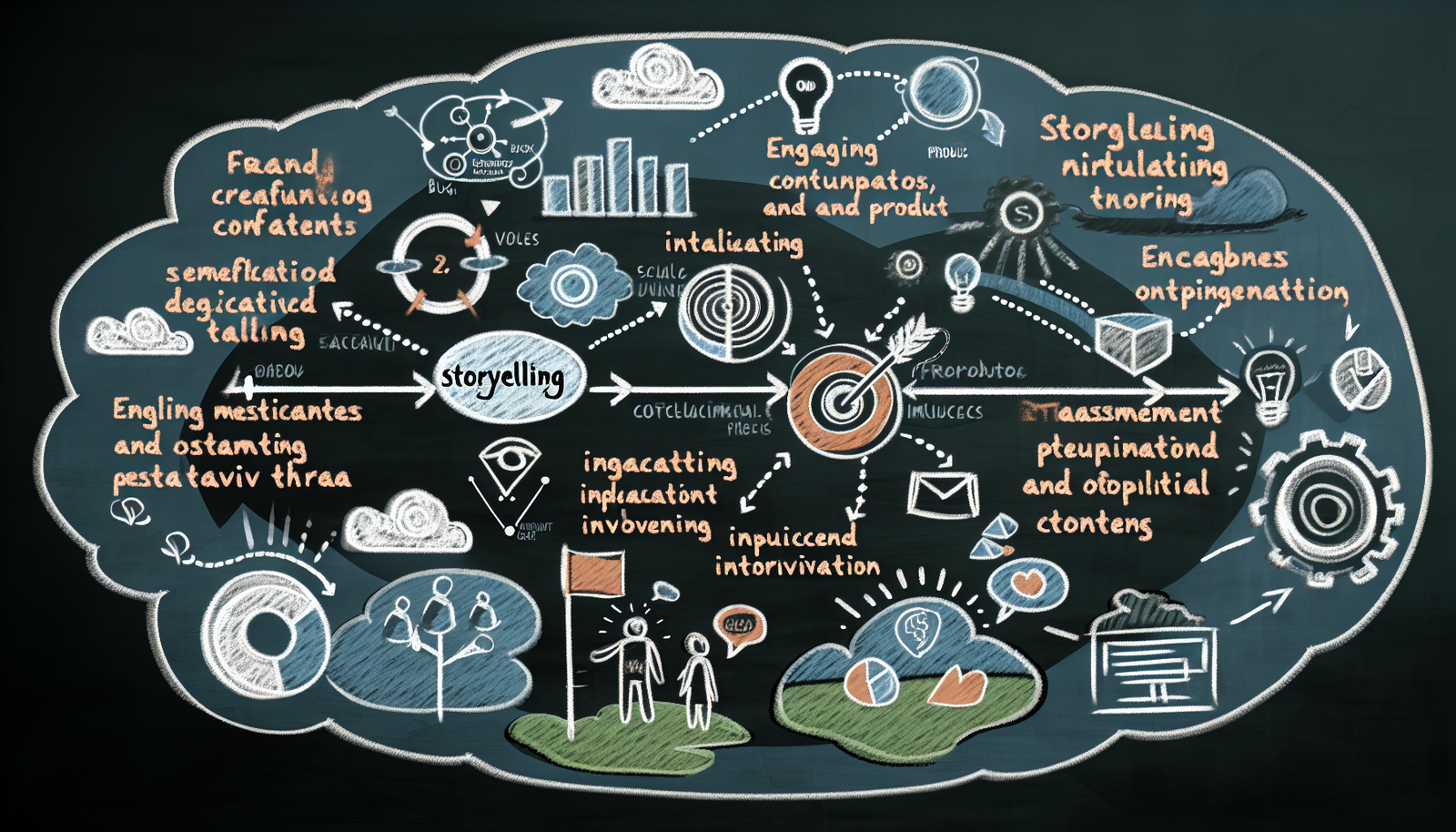
Why Should You Care About Digital Storytelling in Marketing?
Imagine flipping through a book with no coherent plot – just a jumble of facts and figures. That’s kind of how marketing without storytelling feels. Digital storytelling is the art of weaving your brand’s values, mission, and products into a coherent narrative that resonates with your audience on an emotional level. It’s about creating connections, not just transactions.
What’s the Buzz Around Brand Narratives?
A brand narrative isn’t just a fancy buzzword; it’s your company’s heartbeat. It’s the story that encapsulates who you are, what you stand for, and why you matter to your customers. When done correctly, it’s a powerful tool that can transform casual browsers into loyal ambassadors for your brand.
- How can I create a brand narrative? Start by defining your brand’s core values and mission.
- How do I tell my brand’s story? Through carefully crafted content that’s consistent across all digital platforms.
- What makes a good brand narrative? Authenticity, relatability, and the ability to evoke emotions.
Can Content Marketing Really Tell a Story?
Absolutely! Content marketing and storytelling are like the dynamic duo of the digital world. Engaging content – whether it’s blog posts, videos, or social media updates – allows you to tell your brand’s story in a way that’s meaningful to your audience.
Think about your favorite movie or book. What draws you in? It’s likely the story, the characters, the emotional journey. Apply these principles to your content, and you’ll start to see why storytelling can be such a game-changer for marketing.
How Do You Use Visuals in Storytelling?
In today’s fast-paced digital landscape, a picture isn’t just worth a thousand words – it can be worth a thousand clicks. Visuals like infographics, videos, and images can make your story more engaging and accessible, helping it stand out in a crowded digital space.
- Infographics can simplify complex information and data.
- Videos can capture attention and quickly convey emotions.
- Images can support your narrative and leave a lasting impression.
What’s the Deal with Social Media Stories?
If you’ve been on Instagram, Facebook, or Snapchat lately, you’ve likely noticed the rise of social media stories. These are temporary posts that disappear after 24 hours but have a lasting impact on your audience.
They’re casual, they’re spontaneous, and they’re incredibly powerful for real-time storytelling. But remember to keep your brand’s voice consistent, and don’t be afraid to get creative!
How Do You Get Your Audience to Engage with Your Stories?
Everyone wants to be heard, and your audience is no exception. Engaging storytelling isn’t a monologue – it’s a dialogue.
Encourage user participation by asking questions, creating polls, or inviting user-generated content. Leverage influencers to add credibility and reach to your story. Above all, create content that’s worth talking about.
Are There Any Tools to Help with Storytelling?
The digital world is brimming with storytelling tools that can help you craft, schedule, measure and optimize your narrative across various channels.
From content management systems to analytics platforms, the right tools can take your storytelling from good to great. And with AI technology on the rise, personalized storytelling has never been easier – or more impactful.
How Do You Measure the Impact of Storytelling?
Like any good story, the impact of your digital storytelling should be measurable. Utilize analytics tools to track engagement, set KPIs for your campaigns, and conduct A/B tests to refine your approach.
The data you collect will give you insights into what works, what doesn’t, and where there’s room for improvement. And, yes, this storytelling quest is an ongoing one – always evolving, always improving.
Wrapping It Up
In the vast ocean of digital marketing, storytelling is your beacon. It’s how you make your brand shine brighter than the rest. So whether you’re crafting a blog post or filming a TikTok video, remember that you’re not just selling a product — you’re sharing a story.
Implementing effective storytelling strategies isn’t just a one-time tick-box action; it’s a continual process of shaping, sharing, and refining your brand’s narrative. But when done right, the rewards are priceless – engaging content, loyal customers, and a brand legacy that lasts.

A New Chapter in Marketing: Why Digital Storytelling is a Game-Changer
Have you ever been captivated by a brand’s story? Perhaps it resonated with you, connected on a personal level, or just struck a chord? That’s digital storytelling at work, and it’s transforming the way businesses engage with their audience. As we explore the realm of digital storytelling in 2024, we delve into why it’s so crucial and how it can elevate your brand narrative, content marketing, and more!
The Art of Crafting Your Brand Narrative in the Digital World
What’s a brand narrative, and why does it matter? Simply put, it’s your story – the heartbeat of your brand, shared with the world through digital media. It’s not just what you sell but who you are, your values, your journey, and how it all intertwines to create a unique identity customers can relate to.
- Creating a compelling brand narrative involves reflection and creativity. It means diving deep to uncover the essence of your brand and weaving it into a story that’s original and engaging.
- Incorporate brand values strategically – your brand’s principles should be the stars of your story, shining through every piece you share.
- Aligning with your audience is key. Understand their values and craft a narrative that speaks their language and resonates with them on an emotional level.
By leveraging storytelling techniques, you can foster a deeper connection with your customers, nurturing trust and loyalty that extends far beyond a simple transaction.
Content Marketing with a Storytelling Twist
The core of content marketing is simple: provide value. But when you fuse this with storytelling, you transcend from purely informational to enchanting, engaging content. Here’s the secret sauce:
- Develop a strategy that anchors your storytelling at the heart of your content creation.
- Engaging content is content that tells a story, whether it’s a blog post, video, or infographic – think narratives that educate, inspire, entertain, or all three.
- Leverage different formats and distribute your content across channels where your audience loves to be, keeping your story consistent and compelling.
Measure the success of your campaigns by evaluating engagement, conversion rates, and the emotional responses they evoke.
Visual Storytelling: Paint a Thousand Words
Visual storytelling – sounds buzzwordy, right? But it’s the bedrock of conveying complex ideas in a blink. It’s about images, videos, infographics that draw viewers into your brand’s world.
- Keep your visuals aligned with your brand for a consistent narrative across all platforms.
- Creative techniques, like mixing live-action with animation or using augmented reality, can elevate your campaign’s storytelling to new heights.
- Evaluate the effectiveness of your visual stories by tracking engagement metrics and feedback – it’s about understanding what visual dialect speaks to your audience.
The Social Media Story Arc
Nowadays, ephemeral content like Instagram, Facebook, and Snapchat stories allows you to craft quick, captivating narratives that give a behind-the-scenes look into your brand. They’re like digital campfires where stories are shared, inviting user interaction and creating a sense of urgency.
Use social media stories to:
- Enhance your brand narrative with real-time content.
- Encourage audience participation with polls and questions.
- Incorporate user-generated content to show your brand’s impact on real people.
Keep track of their performance through analytics, and stay agile, ready to jump on the next storytelling trend!
Engaging Audiences: The Heart of Digital Storytelling
Engagement isn’t just a buzzword; it’s the lifeline of your storytelling efforts. Understanding audience preferences and behaviors is crucial to crafting stories that captivate and hold attention. Ask yourself:
- Are the stories we’re telling evoking emotions?
- Are we encouraging participation from our audience?
- How are we building a community around our brand narrative?
By leveraging influencers, creating interactive experiences, and always listening to feedback, you can refine your storytelling to better connect with those you’re trying to reach.
Choosing the Right Tools for Your Storytelling Arsenal
Just like a skilled craftsman has a favorite set of tools, digital marketers in 2024 have an array of storytelling tools at their disposal:
- Content creation platforms that bring stories to life.
- Analytics tools that dissect the impact of each story.
- Feedback systems that refine the narrative based on real audience reactions.
- AI that can help tailor stories to individual user preferences.
Choosing the right tool depends on your story, your audience, and your objectives – so choose wisely and maximize the impact of your storytelling.
Measuring Impact: The Story’s Climax
Let’s bring it home – how do you know if your storytelling efforts are paying off? It’s all in the metrics. Tracking traffic, engagement, conversion rates, and even brand sentiment gives you the full picture of your storytelling’s effect.
But don’t just collect data – analyze and act on it! Use A/B testing to refine your approach, delve into analytics for deeper insights, and always, always aim to improve the connection between your brand’s story and your audience.
Conclusion
We’ve just scratched the surface of the rich tapestry that is digital storytelling in 2024. Let’s remember, the core of digital marketing is still storytelling, and with the right narrative, visual splendor, social media strategy, and audience engagement, your brand’s story can become one for the ages. Take these insights, apply them innovatively, and write the next chapter of your success story.

Brand Narratives in Digital Marketing
Digital storytelling has transformed the landscape of content marketing remarkably. One of the core elements pivotal to this change is the emergence and prioritization of a robust brand narrative. But what exactly is a brand narrative, and why does it matter so much in digital marketing? Let’s dig in.
Understanding the Brand Narrative
A brand narrative isn’t just about what you sell; it’s the story of who you are and why you exist. It’s a cohesive, ongoing narrative that interweaves facts, emotions, and interpretations that your brand wants to share with the world. More than advertising a product or service, it’s about building a connection with your audience based on shared values and experiences.
Crafting Your Brand Narrative
A compelling narrative isn’t born overnight; it’s carefully crafted. Here are key steps to keep in mind:
- Identify Your Core Values: Determine what your brand stands for. These values will serve as the foundation of your narrative.
- Know Your Audience: Understand who you’re talking to. Tailor your narrative to resonate with your audience’s needs and desires.
- Find Your Unique Angle: What sets you apart? Ensure that your narrative offers a different perspective, one that’s uniquely yours.
- Be Authentic: Authenticity builds trust. Let your brand’s true personality shine through your narrative, and consistency here is key.
Incorporating Values into Your Brand Narrative
It’s crucial that your brand’s values are not just stated but also actively demonstrated in your narrative. This could be through the stories you tell about your customers, the behind-the-scenes glimpses of your company, or how your products are making a difference. People remember stories that touch them, so your narrative should aim to do just that.
Aligning with Your Audience
Your audience wants to see themselves in your brand story. This means understanding their wants, needs, and the channels they frequent. Conduct research, gather data, and use this information to craft narratives that speak directly to their hearts.
Building Trust Through Storytelling
Stories are powerful tools for building brand trust and loyalty. They help humanize your brand, making it more relatable and trustworthy. Through meaningful narratives, customers become part of your story, which fosters loyalty and advocacy.
Successful Brand Narratives in Action
Many brands have leveraged digital storytelling to create a lasting impression. For instance, Dove’s “Real Beauty” campaign went beyond selling soap; it sparked conversations about beauty standards and self-esteem. By aligning with their audience’s values and aspirations, Dove strengthened its brand narrative and resonated deeply with consumers.
Marketing Channels for Storytelling
To ensure your brand narrative is heard, it must be effectively spread across all marketing channels. Be it via email campaigns, social media posts, or your website; your brand’s story should be consistent and omnipresent. Tailor the narrative to fit the format and audience of each channel, but keep the core message the same.
Measuring Your Brand Narrative’s Impression
Finally, it’s crucial to measure how your brand narrative impacts consumer perception. This can be done through social listening tools, surveys, and analyzing changes in engagement and sales patterns. Use this data to refine and improve your narrative continually.
In conclusion, a cohesive and engaging brand narrative is crucial in digital storytelling and content marketing. It’s more than a marketing strategy; it’s the heart and soul of your brand’s identity in the digital space. As we move further into 2024, the brands that tell the best stories will be the ones that stand out and build lasting relationships with their customers.
 “`html
“`html
Understanding the Role of Content in Digital Marketing
Have you ever wondered why content marketing seems to be the buzzword flying around every marketing meeting? Well, content is king, as they say, and in the kingdom of digital marketing, it’s the stories told through this content that help build your brand narrative and connect with your audience on a deeper level. Let’s dive into why storytelling in your content can make a huge difference.
Developing a Story-Based Content Marketing Strategy
Stories spark emotions and create connections. That’s why a content marketing strategy that’s built on the foundation of storytelling is bound to be powerful. Whether it’s through blog posts, videos, or social media, your content should tell the story of your brand: who you are, what values you stand for, and why your audience should care.
Creating Engaging Content for Your Audience
No two audiences are the same, so getting to know yours is crucial. What do they find interesting? What challenges are they facing that you can solve? By understanding this, you can craft content that not only informs but also entertains and inspires your audience. This is the content that gets liked, shared, and remembered.
The Art of Weaving Storytelling Elements Into Your Content
- Start with a compelling hook that grabs attention.
- Include real-life scenarios or anecdotes to make your points relatable.
- Use vivid imagery and descriptive language to paint a picture in the reader’s mind.
- Establish a clear beginning, middle, and end to give your content structure.
- Show the human side of your brand by sharing behind-the-scenes stories when relevant.
Varying Your Content Formats
Don’t get stuck in a content rut! Utilize a mix of formats—from blog posts and infographics to podcasts and webinars—to keep your audience engaged and cater to different content consumption preferences. Each format has its unique way of telling a story, so mix and match to discover what resonates best with your audience.
Distributing Your Stories: Promote, Promote, Promote!
Even the best stories need an audience. Once you’ve created your content, it’s crucial to get it out there through strategic distribution. Share it on the right channels where your audience hangs out. Don’t forget to encourage sharing to maximize reach.
Measuring Your Story’s Impact
How do you know if your storytelling is effective? By measuring its impact. Track engagement metrics such as likes, shares, comments, and conversion rates. These numbers tell you what’s working and what isn’t. Remember, the data is telling you a story, too—about your audience.
Refining Your Approach Based on Insights
Listen to the feedback and analyze the data you get from your content. It can guide you to refine your strategy, helping you to craft even more compelling narratives that hit the right chords with your audience.
Engaging and Captivating: The Final Word on Digital Storytelling in Content Marketing
Digital storytelling is not just about selling a product or service; it’s about creating a lasting impact through the art of storytelling. It’s about building a community around your brand narrative and transforming audiences into brand advocates. So, take these insights, get creative with your content, and start telling your brand’s unique story!
“`

The Power of Visual Storytelling in Digital Marketing
Ever wonder why certain brand messages resonated with you more than others? Chances are, they employed visual storytelling to create a lasting impression. Visuals have a unique ability to convey emotions, drive engagement, and ultimately, shape our perceptions of brands. Let’s delve into how visual storytelling elevates digital marketing.
Incorporating Visual Elements into Brand Narratives
Successful brand narratives often feature visuals that relate directly to the storyline. It’s not just about having pretty pictures; it’s about selecting images that deepen the narrative and connect with the audience on an emotional level. A video explaining a product’s impact or an infographic breaking down complex data can significantly reinforce your message.
Enhancing Storytelling with Infographics, Videos, and Images
Each visual format serves a unique purpose in content marketing. Infographics simplify and present data attractively, making it easy to digest. Videos, on the other hand, can convey a ton of information within a short span, capturing attention effectively. Meanwhile, images can break up text and add context to your brand’s story.
Choosing the Right Visual Content for Different Platforms
It’s crucial to tailor your visuals to the platform you’re using. For instance, Instagram demands high-quality, eye-catching images, while YouTube is the go-to for longer, informative videos. Aligning your visual content with the platform not only enhances relevance but also ensures that it’s seen and appreciated by your target audience.
Creating Visually Compelling Storytelling Campaigns
Here are a few techniques for developing visually appealing storytelling campaigns:
- Consistency: Maintain a consistent color scheme and style to reinforce brand recognition.
- Quality: Invest in high-quality visuals. Blurry or low-resolution images can harm your brand’s credibility.
- Relevance: Ensure that your visual content aligns with the story and message you want to communicate.
Measuring the Impact of Visual Storytelling
To understand how effective your visuals are in storytelling, track engagement levels, such as shares, comments, and time spent on your content. These metrics will help you gauge the impact and refine your approach if necessary.
Evolving Trends in Visual Storytelling for Digital Marketing
Stay ahead of the curve by keeping an eye on emerging trends. Augmented Reality (AR) and Virtual Reality (VR) are quickly gaining traction, significantly enhancing the user experience and providing immersive brand narratives. Likewise, animated elements and interactive infographics boost audience engagement.
Conclusion
Visual storytelling has transformed content marketing and established new ways for brands to convey their narratives and values. Compelling visual content can significantly impact brand perception, making it an indispensable tool in your digital marketing toolkit. So, harness the power of visuals, and let your brand’s unique story shine.

A Glimpse into the World of Social Media Stories
It’s amazing how social media stories have weaved their way into the fabric of digital storytelling. These ephemeral snippets of content are not just for sharing what you had for breakfast anymore—no, no. They’ve become a powerhouse for brands looking to engage with audiences on a more personal, narrative-driven level. Let’s dig in and explore the huge role stories play in crafting an enticing brand narrative and in content marketing.
Embracing the Ephemeral: Making the Most of Stories
Whether it’s on Instagram, Facebook, or Snapchat, stories offer a raw and authentic glimpse into the ‘here and now’ of a brand. By sharing in-the-moment content, you’re inviting your audience to a backstage tour of your brand, building intimacy, and trust along the way.
Creating a Buzz with Instagram and Facebook Stories
Have you ever wished you could be a fly on the wall in your favorite brand’s office or design room? Instagram and Facebook stories allow just that. By taking advantage of the various features such as polls, questions, and live videos, brands can create interactive experiences that engage audiences and invite them into their world.
- Polls: They spark curiosity and encourage participation.
- Questions: A great way to gather feedback and connect directly with your audience.
- Live Videos: Nothing beats the excitement of live interaction. It’s unfiltered and personal.
The key is to maintain a consistent narrative across different platforms, ensuring your story remains clear no matter where your audience views it.
Emphasizing the Here and Now on Snapchat Stories
Snapchat stories might feel like they’re in their own little ephemeral bubble, but they are as potent as any other story medium. Go candid. The uncurated, spontaneous vibe of Snapchat resonates well with a younger demographic that values authenticity over perfection.
From Passive Watchers to Active Participants
What makes social media stories so captivating is the invitation for the audience to join in. Through direct replies, shared hashtags, or even crowdsourced content, your followers can become part of the storytelling process—bridging the gap between brand and consumer.
User-Generated Content: Your Brand, Through Their Eyes
Encouraging your audience to share their own stories and experiences with your brand can have a powerful, multiplying effect. It’s like word-of-mouth marketing on steroids! User-generated content can make your brand feel more accessible and trustworthy.
Analyzing the Story Success
Tracking the success of your social media stories is as crucial as creating them. With the built-in analytics that most social platforms provide, you can measure reach, views, and engagement. Use this data to fine-tune your approach, and never stop experimenting with different storytelling formats to see what resonates best with your audience.
Staying Trendy: Keep Your Stories Fresh
Social media is an ever-evolving landscape. What worked yesterday may not work today. So, it’s essential to keep up with the latest trends. Whether it’s the newest filter, feature, or challenge, staying updated will help your stories stay relevant and engaging.
In conclusion…
Think of social media stories as the digital campfire around which your audience gathers to hear what you have to say. Engage them with interactive, timely content, and measure what works to keep your storytelling game strong. Remember, the power of a great brand narrative is not just in telling but in the shared experience and engagement it stimulates.
So go on, show the world what your brand’s story looks like—one disappearing snippet at a time!

VI. Engaging Audiences
When it comes to digital storytelling in the ever-evolving realm of content marketing, the spotlight often shines brightest on engaging audiences. An engaged audience isn’t just a passive consumer of information; they become a part of the brand’s journey, contributing to its narrative and success. The magic of a powerful brand narrative lies in its ability to captivate an audience, forging a bond that goes beyond the digital screen.
A. Importance of Audience Engagement in Storytelling
Imagine your brand narrative as a campfire tale. A great storyteller can make listeners feel every emotion, anticipate every twist, and remember the story long after the fire dies down. It’s the same with digital storytelling – it’s not just about conveying information, but rather creating a memorable experience that resonates with your audience on a deeper level.
B. Understanding Audience Preferences and Behaviors
To strike a chord with your audience, start by truly understanding them. Who are they? What are their challenges, desires, or dreams? Crafting a story that’s relevant entails delving into the psychographics, not just demographics, of your target audience, ensuring every word speaks directly to their personal experience.
C. Segmenting Target Audience for Personalized Storytelling
Not all members of your audience are the same, so why treat them that way? Segmentation is crucial. By dividing your audience into smaller groups based on specific criteria, you can tailor your storytelling to address the unique desires and pain points of each group, making your messages more impactful.
D. Crafting Emotionally Compelling Stories to Captivate Audiences
Emotion is the core of human decision-making, and it plays a pivotal role in storytelling. A narrative that sparks joy, inspiration, sadness, or hope is much more likely to be remembered and shared. Your brand’s story should be a journey of emotions that aligns with your audience’s values and beliefs.
E. Encouraging User Participation and Interaction Through Storytelling
The interactive nature of the digital world means that your story doesn’t have to be a monologue. Encourage your audience to participate – be it through leaving comments, sharing user-generated content, or joining in challenges and conversations. This way, they’re not just audience members; they’re part of the story itself.
F. Leveraging Influencers and User-Generated Content to Engage Audiences
Influencers and user-generated content can be powerful tools in amplifying your brand’s reach and relatability. When your audience sees real people endorsing your brand or contributing their own stories, it adds authenticity and trust, making your narrative that much stronger.
G. Building Communities Around Brand Narratives for Ongoing Engagement
Build a realm where your brand narrative flourishes not just as a story, but as a community. Whether it’s through social media groups, forums, or in-person events, fostering a sense of belonging can turn casual consumers into loyal brand advocates.
H. Analyzing Audience Feedback and Adjusting Storytelling Strategies Accordingly
Finally, listen to what your audience has to say about your story. Their feedback is invaluable in fine-tuning your approach and ensuring your narrative hits the right notes. Be agile, be adaptable, and always seek to improve the connection between your brand and its audience.
As you weave these rich threads of content marketing and digital storytelling into your brand tapestry, you create more than a mere marketing campaign; you create a living, breathing narrative. By putting a heavy focus on audience engagement, you’re not just selling a product or service, you’re building a legacy – and with brand narrative at the helm, that legacy will endure in the minds and hearts of your consumers.

Understanding the Latest Storytelling Tools for Digital Marketers in 2024
Hello, digital storytelling enthusiasts! If you’ve been immersed in the world of digital storytelling and content marketing, you know that having the right tools can make all the difference in crafting a compelling brand narrative. With new technologies constantly shaping the digital landscape, it’s essential to stay updated with the storytelling tools that are defining marketing in 2024. Let’s explore some of the latest options that can take your storytelling to the next level.
Dive into Content Creation and Management Magic
Firstly, content creation and management tools have advanced leaps and bounds, offering features that streamline processes and enhance creativity. From AI-driven copywriting assistants to comprehensive content calendars, the aim is to ensure that your narrative flows consistently across all channels.
- Canva: A veteran in the visual creation space, Canva now offers even more templates and customization for your graphics and designs.
- Hootsuite: This tool keeps evolving, catering to all your scheduling needs across various platforms with a user-friendly interface.
- Grammarly: Beyond grammar checks, Grammarly now offers tone suggestions to ensure that your content aligns with your brand voice.
Unraveling the Narrative with Analytics and Visualization
Measuring the impact of your storytelling efforts is crucial. Analytics and data visualization tools have become more intuitive and provide deeper insights into how your content resonates with audiences.
- Google Analytics: The old standby continues to innovate, bringing more granular insights into customer journeys and content engagement.
- Tableau: With advanced data storytelling features, Tableau helps you visualize your brand’s narrative through data.
- Hotjar: An essential tool for understanding user behavior, Hotjar’s heatmaps can show you exactly where your story is capturing attention.
Streamline Your Socials
Keeping your social media channels buzzing with fresh stories is a full-time job. Fortunately, social media management tools have become smarter and more integrated, allowing you to maintain a cohesive narrative without the hassle.
- Buffer: Buffer’s intuitive platform makes it simple to craft and schedule posts, ensuring your story is heard loud and clear.
- Later: Tailored for visual stories, Later helps you plan your Instagram stories and posts efficiently.
- Brandwatch: Keep your finger on the pulse by tracking trends and mentions that might influence your storytelling strategy.
Innovate with Collaboration
A storyteller’s job isn’t solitary. Collaboration tools designed for digital marketing teams have enhanced features for brainstorming and bringing your brand’s story to fruition.
- Slack: Rapid communication is vital, and Slack channels keep your team connected and the narrative on track.
- Asana: Asana takes project management to the next level with new integrations and workflow automation for your storytelling campaigns.
Feedback and Optimization at Your Fingertips
Your story isn’t set in stone. User testing and feedback tools are integral to refining your narrative and ensuring it resonates with your audience.
- UsabilityHub: Test your designs and content with real users to get actionable insights you can use to improve your storytelling.
- SurveyMonkey: Gather opinions and feedback to tweak and tailor your stories to what your audience wants to hear.
The AI Storytelling Revolution
Artificial intelligence is revolutionizing storytelling, from content curation to predictive analytics. Embrace AI-powered tools to craft personalized and engaging narratives that captivate your audience.
- OpenAI: Leveraging natural language processing to generate content suggestions or even draft stories for you.
- PaveAI: Turns Google Analytics data into actionable storytelling strategies with AI-powered recommendations.
Choose Your Weapons Wisely
In conclusion, while the plethora of storytelling tools at your disposal in 2024 might seem overwhelming, the key is to choose the ones that fit seamlessly with your brand’s objectives. Experiment with different tools, mix and match their features, and always keep an eye on the effectiveness of your narratives. Remember, the tool should enhance your story, not overshadow it. Use these powers wisely, and watch your brand narrative flourish in the digital realm!

Measuring the Impact of Your Digital Storytelling Efforts
In the world of digital marketing, weaving an effective brand narrative isn’t just about creating a good story; it’s also about understanding how that story performs. Let’s dive into how you measure the impact of your storytelling to ensure your content marketing efforts are not just resonating with your audience but also contributing to your brand’s success.
Why Is Measuring Storytelling Impact So Crucial?
Storytelling isn’t just an art; it’s a strategic tool that can profoundly affect your brand’s presence in the digital space. By measuring its impact, you can:
- Understand your audience’s preferences and reactions to different stories.
- Allocate resources more effectively, favoring strategies that yield results.
- Refine and optimize your content to drive better engagement and conversion rates.
Setting Up Measurement Metrics and KPIs
First things first, identify what success looks like for your brand. Are you aiming for more website traffic, enhanced brand awareness, or increased sales? Once you’ve set your goals, establish Key Performance Indicators (KPIs) that align with these objectives, such as:
- Engagement rates including likes, shares, comments, and time spent on page.
- Conversion rates tracking how many users performed a desired action.
- Brand sentiment, assessing how people feel about your brand after interacting with your content.
Assessing Effectiveness with Data Analytics
Your arsenal for measuring the storytelling impact is incomplete without data analytics. Tools like Google Analytics can provide a wealth of information. Look for changes in user behavior, page views, and bounce rates in response to your storytelling campaigns. It’s like having a crystal ball that gives you insights into what’s working and what’s not.
Optimization Through A/B Testing
Don’t be afraid to experiment. Running A/B tests can help you determine which aspects of your storytelling resonate most. Maybe one version of a story leads to more newsletter sign-ups, whereas another increases social sharing. Use this data to tailor your future narratives.
Understanding Brand Awareness and Sentiment
Storytelling goes beyond just clicks and views; it’s about perception. Utilize social listening tools to gauge brand sentiment and see how your stories influence public opinion about your brand. This qualitative data can be as valuable as quantitative metrics like traffic and conversion rates.
Evaluating User Engagement and Conversions
A superb story should lead to action. Track how your storytelling efforts affect user engagement and conversion rates. Do more people sign up for your service after a particular campaign? Do they spend longer on your site after reading your brand’s story? These are key indicators of a successful brand narrative.
Loyalty and Retention: The Ultimate Test
Loyal customers are the best testament to your digital storytelling. Monitor customer retention rates and the frequency of repeat purchases. If your storytelling is captivating, customers will return, and they’ll bring friends.
Continuous Analysis for Improvement
Effective storytelling is an ongoing process. Regularly review your metrics, adjusting your strategy as necessary. What are the trends? What feedback does your audience give? Keep your finger on the pulse of your brand’s story to stay relevant and compelling.
Conclusion
Effective content marketing and digital storytelling are about painting a picture that not only draws in your audience but also drives them to action. By measuring its impact meticulously, you can refine your approach, ensuring your brand narrative not only sings but also rings the cash register. The digital age is all about stories that captivate and convert; make sure yours do both by keeping tabs on these essential metrics.

